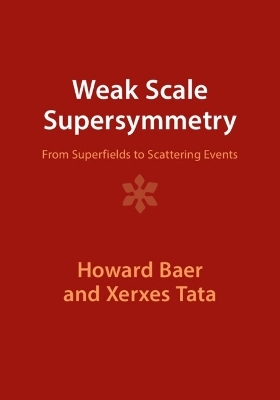
Weak Scale Supersymmetry
From Superfields to Scattering Events
Seiten
2023
|
Revised edition
Cambridge University Press (Verlag)
978-1-009-28983-2 (ISBN)
Cambridge University Press (Verlag)
978-1-009-28983-2 (ISBN)
This 2006 text develops the basic concepts of supersymmetry and shows how it can be incorporated into a theoretical framework for describing unified theories of elementary particles, for experimental and phenomenological particle physicists and graduate students. It has been reissued as an Open Access publication on Cambridge Core.
Supersymmetric models of particle physics predict new superpartner matter states for each particle in the Standard Model. These superpartners will have wide ranging implications, from cosmology to observations at high energy accelerators, such as CERN's LHC. In this 2006 text, the authors develop the basic concepts of supersymmetry and show how it can be incorporated into a theoretical framework for describing unified theories of elementary particles. They develop the technical tools of supersymmetry using four-component spinor notation familiar to high energy experimentalists and phenomenologists. The text takes the reader from an abstract formalism to a straightforward recipe for writing supersymmetric gauge theories of particle physics, and ultimately to the calculations necessary for practical applications at colliders and in cosmology. This is a comprehensive, practical and accessible introduction to supersymmetry for experimental and phenomenological particle physicists and graduate students. It has been reissued as an Open Access publication on Cambridge Core.
Supersymmetric models of particle physics predict new superpartner matter states for each particle in the Standard Model. These superpartners will have wide ranging implications, from cosmology to observations at high energy accelerators, such as CERN's LHC. In this 2006 text, the authors develop the basic concepts of supersymmetry and show how it can be incorporated into a theoretical framework for describing unified theories of elementary particles. They develop the technical tools of supersymmetry using four-component spinor notation familiar to high energy experimentalists and phenomenologists. The text takes the reader from an abstract formalism to a straightforward recipe for writing supersymmetric gauge theories of particle physics, and ultimately to the calculations necessary for practical applications at colliders and in cosmology. This is a comprehensive, practical and accessible introduction to supersymmetry for experimental and phenomenological particle physicists and graduate students. It has been reissued as an Open Access publication on Cambridge Core.
Preface; 1. The Standard Model; 2. What lies beyond the Standard Model; 3. The Wess-Zumino model; 4. The supersymmetry algebra; 5. Superfield formalism; 6. Supersymmetric gauge theories; 7. Supersymmetry breaking; 8. The Minimal Supersymmetric Standard Model; 9. Implications of the MSSM; 10. Local supersymmetry; 11. Realistic supersymmetric models; 12. Sparticle production at colliders; 13. Sparticle decays; 14. Supersymmetric event generation; 15. The search for supersymmetry at colliders; 16. R parity violation; 17. Epilogue; Appendices.
| Erscheinungsdatum | 30.01.2023 |
|---|---|
| Zusatzinfo | Worked examples or Exercises |
| Verlagsort | Cambridge |
| Sprache | englisch |
| Maße | 178 x 253 mm |
| Gewicht | 1060 g |
| Themenwelt | Naturwissenschaften ► Physik / Astronomie ► Atom- / Kern- / Molekularphysik |
| Naturwissenschaften ► Physik / Astronomie ► Hochenergiephysik / Teilchenphysik | |
| ISBN-10 | 1-009-28983-7 / 1009289837 |
| ISBN-13 | 978-1-009-28983-2 / 9781009289832 |
| Zustand | Neuware |
| Haben Sie eine Frage zum Produkt? |
Mehr entdecken
aus dem Bereich
aus dem Bereich
Buch | Softcover (2024)
Wiley-VCH (Verlag)
CHF 83,85


